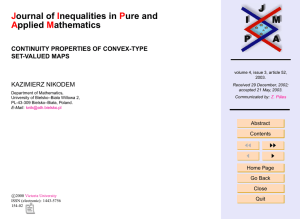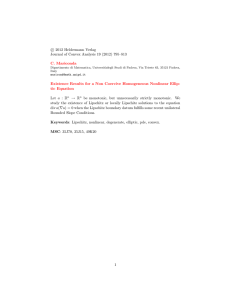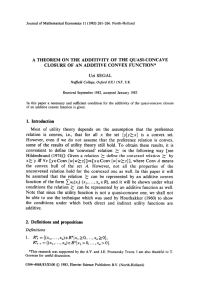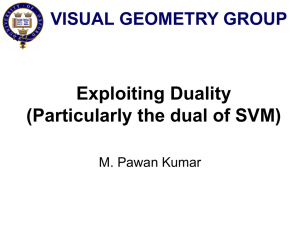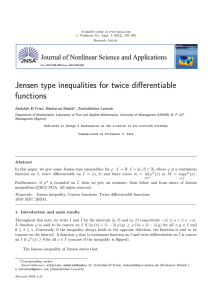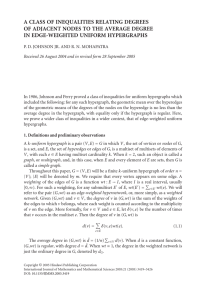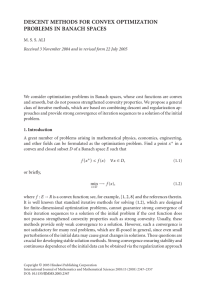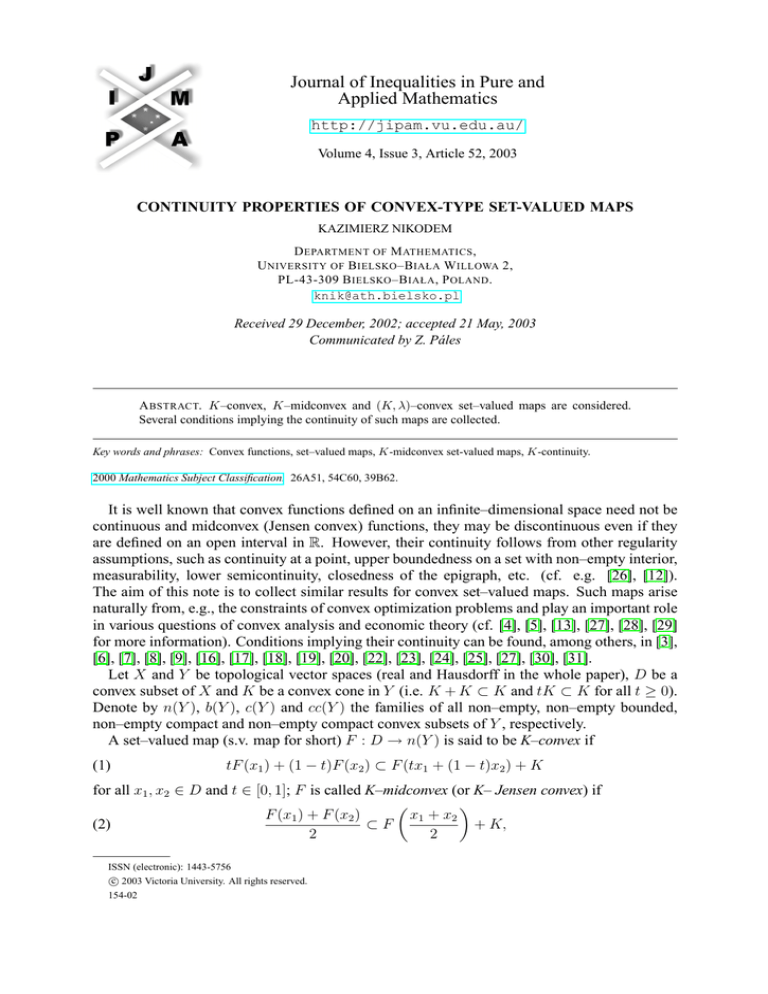
Journal of Inequalities in Pure and
Applied Mathematics
http://jipam.vu.edu.au/
Volume 4, Issue 3, Article 52, 2003
CONTINUITY PROPERTIES OF CONVEX-TYPE SET-VALUED MAPS
KAZIMIERZ NIKODEM
D EPARTMENT OF M ATHEMATICS ,
U NIVERSITY OF B IELSKO –B IAŁA W ILLOWA 2,
PL-43-309 B IELSKO –B IAŁA , P OLAND .
knik@ath.bielsko.pl
Received 29 December, 2002; accepted 21 May, 2003
Communicated by Z. Páles
A BSTRACT. K–convex, K–midconvex and (K, λ)–convex set–valued maps are considered.
Several conditions implying the continuity of such maps are collected.
Key words and phrases: Convex functions, set–valued maps, K-midconvex set-valued maps, K-continuity.
2000 Mathematics Subject Classification. 26A51, 54C60, 39B62.
It is well known that convex functions defined on an infinite–dimensional space need not be
continuous and midconvex (Jensen convex) functions, they may be discontinuous even if they
are defined on an open interval in R. However, their continuity follows from other regularity
assumptions, such as continuity at a point, upper boundedness on a set with non–empty interior,
measurability, lower semicontinuity, closedness of the epigraph, etc. (cf. e.g. [26], [12]).
The aim of this note is to collect similar results for convex set–valued maps. Such maps arise
naturally from, e.g., the constraints of convex optimization problems and play an important role
in various questions of convex analysis and economic theory (cf. [4], [5], [13], [27], [28], [29]
for more information). Conditions implying their continuity can be found, among others, in [3],
[6], [7], [8], [9], [16], [17], [18], [19], [20], [22], [23], [24], [25], [27], [30], [31].
Let X and Y be topological vector spaces (real and Hausdorff in the whole paper), D be a
convex subset of X and K be a convex cone in Y (i.e. K + K ⊂ K and tK ⊂ K for all t ≥ 0).
Denote by n(Y ), b(Y ), c(Y ) and cc(Y ) the families of all non–empty, non–empty bounded,
non–empty compact and non–empty compact convex subsets of Y , respectively.
A set–valued map (s.v. map for short) F : D → n(Y ) is said to be K–convex if
(1)
tF (x1 ) + (1 − t)F (x2 ) ⊂ F (tx1 + (1 − t)x2 ) + K
for all x1 , x2 ∈ D and t ∈ [0, 1]; F is called K–midconvex (or K– Jensen convex) if
F (x1 ) + F (x2 )
x1 + x2
⊂F
+ K,
(2)
2
2
ISSN (electronic): 1443-5756
c 2003 Victoria University. All rights reserved.
154-02
2
K AZIMIERZ N IKODEM
for all x1 , x2 ∈ D. Equivalently, F is K–convex (K–midconvex) if its epigraph, i.e. the set
epiF = {(x, y) ∈ D × Y : y ∈ F (x) + K},
is a convex (midconvex) subset of X × Y .
Note that F is K–convex (K–midconvex) with K = {0} iff its graph, i.e. the set
grF = {(x, y) ∈ D × Y : y ∈ F (x)},
is a convex (midconvex) subset of X × Y .
If F is single–valued and Y is endowed with the relation ≤K of partial order defined by
x ≤K y :⇐⇒ y − x ∈ K, then condition (1) reduces to the following one
F (tx1 + (1 − t)x2 ) ≤K tF (x1 ) + (1 − t)F (x2 ).
In particular if Y = R and K = [0, ∞), we obtain the standard definition of convex functions.
We say that a set–valued map F : D → n(Y ) is K–continuous at a point x0 ∈ D if for every
neighbourhood W of zero in Y there exists a neighbourhood U of zero in X such that
(3)
F (x0 ) ⊂ F (x) + W + K
and
(4)
F (x) ⊂ F (x0 ) + W + K
for every x ∈ (x0 + U ) ∩ D. Only when condition (3) (condition (4)) is fulfilled, we say
that F is K–lower semicontinuous (K–upper semicontinuous) at x0 . The K–continuity in the
case where K = {0} means the continuity with respect to the Hausdorff topology on n(Y ).
If K is a normal cone (i.e. if there exists a base W of neighbourhoods of zero in Y such that
W = (W − K) ∩ (W + K) for every W ∈ W) and F is a single–valued function, then K–
continuity means continuity. Note also that in the case where F is a real–valued function and
K = [0, ∞) then conditions (3) and (4) define the classical upper and lower semicontinuity of
F at x0 , respectively.
We start with the following result showing that for K–midconvex s.v. maps K–lower semicontinuity at a point implies K–continuity on the whole domain.
Theorem 1. ([17, Thm. 3.3]; cf. also [6]). Let X and Y be topological vector spaces, D be
a convex open subset of X, and K be a convex cone in Y . Assume that F : D → b(Y ) and
G : D → n(Y ) are s.v. maps such that G(x) ⊂ F (x) + K, for all x ∈ D. If F is K–midconvex
and G is K–lower semicontinuous at a point of D, then F is K–continuous on D.
As an immediate consequence of this theorem (under the same assumptions on X, Y , D
and K) we get the following corollaries. Recall that a function f : D → Y is a selection of
F : D → n(Y ) if f (x) ∈ F (x) for all x ∈ D.
Corollary 2. If a s.v. map F : D → b(Y ) is K–midconvex and K–lower semicontinuous at a
point of D, then it is K–continuous on D.
Corollary 3. If a s.v. map F : D → b(Y ) is K–midconvex and has a selection continuous at a
point of D, then it is K–continuous on D.
In the centre of many results giving conditions under which midconvex (or convex) functions are continuous there are two basic theorems. The first one is the theorem of Bernstein
and Doetsch, stating that midconvex functions bounded above on a set with non-empty interior are continuous, and the second one is the theorem of Sierpiński, stating that measurable
midconvex functions are continuous (cf. [26], [12]). The next two theorems are far–reaching
generalizations of those results for K–midconvex s.v. maps.
J. Inequal. Pure and Appl. Math., 4(3) Art. 52, 2003
http://jipam.vu.edu.au/
C ONTINUITY P ROPERTIES OF C ONVEX - TYPE S ET-VALUED M APS
3
We say that an s.v. map F is K–upper bounded on a set A if there exists a bounded set
B ⊂ Y such that F (x) ∩ (B − K) 6= ∅, for all x ∈ A.
Theorem 4. ([17, Thm. 3.4]). Let X and Y be topological vector spaces, D – an open convex
subset of X and K – a convex cone in Y . If an s.v. map F : D → b(Y ) is K–midconvex and
K–upper bounded on a subset of D with non–empty interior, then F is K–continuous on D.
Remark 5. In the case where X = Rn , it is sufficient to assume that the set A is of positive
Lebesgue measure. Indeed, if F is K–upper bounded on A, then, by the K–midconvexity, it is
also K–upper bounded on the set (A + A)/2, which, by the classical Steinhaus theorem, has
non-empty interior.
Recall that a set–valued map F : Rn ⊃ D → n(Y ) is Lebesgue measurable if for every open
set W ⊂ Y the set
F + (W ) = {t ∈ D : F (x) ⊂ W }
is Lebesgue measurable.
Theorem 6. ([17, Thm. 3.8]; cf. also [30]). Let D be a convex open subset of Rn , Y be a
topological vector space, and K be a convex cone in Y . Assume that F : D → b(Y ) and
G : D → b(Y ) are s.v. maps such that G(x) ⊂ F (x) + K, for all x ∈ D. If F is K–midconvex
and G is Lebesgue measurable, then F is K–continuous on D.
Under the same assumptions on D, Y and K we have the following corollaries.
Corollary 7. If a s.v. map F : D → b(Y ) is K–midconvex and Lebesgue measurable, then it is
K–continuous on D.
Corollary 8. If a s.v. map F : D → b(Y ) is K–midconvex and has a Lebesgue measurable
selection, then it is K–continuous on D.
The next result generalizes the well known result stating that convex functions defined on an
open subset of a finite–dimensional space are continuous.
Theorem 9. ([17, Thm. 3.7]; cf. also [24]). Let D be a convex open subset of Rn , Y be a
topological vector space, and K be a convex cone in Y . If a s.v. map F : D → b(Y ) is
K–convex, then it is K–continuous on D.
Now we present a generalization of the classical closed graph theorem.
Theorem 10. ([18, Thm. 1]). Let X be a Baire topological vector space, D be a convex open
subset of X, Y be a locally convex topological vector space and K be a convex cone in Y .
Assume that there exist compact sets Bn ⊂ Y , n ∈ N, such that
[
(5)
(Bn − K) = Y.
n∈N
If a s.v. map F : D → b(Y ) is K–midconvex and its epigraph is closed in D × Y , then it is
K–continuous on D.
Remark 11. The assumption (5) is trivially satisfied if Y is a locally compact space (and K is
an arbitrary convex cone in Y ). It is also fulfilled if there exists an order unit in Y , i.e. such
an element e ∈ Y that for every y ∈ Y we can find an n ∈ N with y ∈ ne − K (we put then
Bn = {ne}). In particular, if int K 6= ∅, then every element of int K is an order unit in Y . The
above result extends the closed graph theorem proved by Ger [10] for midconvex operators and
crosses with the closed graph theorems due to Borwein [6], Ricceri [25] and Robinson-Ursescu
[27], [31] (cf. also [2]).
J. Inequal. Pure and Appl. Math., 4(3) Art. 52, 2003
http://jipam.vu.edu.au/
4
K AZIMIERZ N IKODEM
The next result generalizes the known theorem stating that lower semicontinuous convex
functions are continuous. Given a convex cone K in a topological vector space Y we denote by
K ∗ the set of all continuous linear functionals on Y which are nonnegative on K, i.e.
K ∗ = {y ∗ ∈ Y ∗ : y ∗ (y) ≥ 0, for every y ∈ K}.
Theorem 12. ([19, Thm. 1]). Let X be a Baire topological vector space, D – a convex open
subset of X, Y – a locally convex topological vector space and K – a convex cone in Y .
Moreover, assume that there exist bounded sets Bn ⊂ Y , n ∈ N, such that condition (5)
holds. If a s.v. map F : D → cc(Y ) is K–midconvex and for every y ∗ ∈ K ∗ the functional
x 7−→ fy∗ (x) = inf y ∗ (F (x)), x ∈ D, is lower semicontinuous on D, then F is K–continuous
on D.
It is easy to check that if a s.v. map F : D → b(Y ) is K–upper semicontinuous at a point,
then for every y ∗ ∈ K ∗ the functional fy∗ defined above is lower semicontinuous at this point.
Therefore, as a consequence of the above theorem, we get the following result.
Corollary 13. Let X, D, Y and K be such as in Theorem 12. If a K–midconvex s.v. map
F : D → cc(Y ) is K–upper semicontinuous on D, then it is K–continuous on D.
Now we will present the Mazur’s criterion for continuity of K–midconvex s.v. maps. It is
related to the following question posed by S. Mazur [15]: In a Banach space E there is given an
additive functional f such that, for every continuous function x : [0, 1] → E, the superposition
f ◦ x is Lebesgue measurable. Is f continuous?
The answer to that question, in the affirmative, was given by I. Labuda and R.D. Mauldin [14].
R. Ger [11] showed that the same remains true in the case where f is a midconvex functional
defined on an open convex subset D of E. More precisely, he proved that each midconvex
functional f : D → E such that for every continuous function x : [0, 1] → D, the superposition
f ◦ x admits a Lebesgue measurable majorant, is continuous. The next theorem is a set-valued
generalization of this result.
Theorem 14. ([20, Thm. 1]). Let E be a real Banach space, D – an open convex subset of E,
Y – a locally convex topological vector space and K – a convex cone in Y . Moreover, assume
that there exist bounded sets Bn ⊂ Y , n ∈ N, such that condition (5) holds. If a set–valued
map F : D → cc(Y ) is K–midconvex and for every continuous function x : [0, 1] → D there
exists a Lebesgue measurable set–valued map G : [0, 1] → c(Y ) such that
G(t) ⊂ F (x(t)) + K , t ∈ [0, 1],
then F is K–continuous on D.
As an immediate consequence of the above theorem (under the same assumptions on E, D,
Y and K ) we obtain the following corollaries.
Corollary 15. If a set–valued map F : D → cc(Y ) is K–midconvex and for every continuous
function x : [0, 1] → D the superposition F ◦x is Lebesgue measurable, then F is K–continuous
on D.
Corollary 16. If a set–valued map F : D → cc(Y ) is K–midconvex and for every continuous
function x : [0, 1] → D the superposition F ◦ x has a Lebesgue measurable selection, then F
is K–continuous on D.
Now assume that λ : D2 → (0, 1) is a fixed function. We say that a set-valued map F : D →
n(Y ) is (K, λ)-convex if
(6)
λ(x, y)F (x) + (1 − λ(x, y))F (y) ⊂ F λ(x, y)x + (1 − λ(x, y))y + K
J. Inequal. Pure and Appl. Math., 4(3) Art. 52, 2003
http://jipam.vu.edu.au/
C ONTINUITY P ROPERTIES OF C ONVEX - TYPE S ET-VALUED M APS
5
for all x, y ∈ D. Clearly, K-convex set-valued maps are (K, λ)-convex with every function
λ; K-midconvex set-valued maps are (K, λ)-convex with the constant function λ = 1/2. For
real-valued functions and K = [0, ∞) condition (6) reduces to
F λ(x, y)x + (1 − λ(x, y))y ≤ λ(x, y)F (x) + (1 − λ(x, y))F (y),
x, y ∈ D.
Such functions were introduced and discussed by Zs. Páles in [21], who obtained a Bernstein–
Doetsch-type theorem for them. The next result is a set-valued generalization of this theorem.
Theorem 17. ([1, Thm. 1]). Let D ⊂ Rn be an open convex set, λ : D2 → (0, 1) be a function
continuous in each variable, Y be a locally convex space and K be a closed convex cone in Y .
If a s.v. map F : D → c(Y ) is (K, λ)-convex and locally K-upper bounded at a point of D,
then it is K-convex.
Finally we present a Sierpiński-type theorem for (K, λ)-convex s.v. maps.
Theorem 18. ([1, Thm. 2]). Let Y , K, and D be such as in Theorem 17 and λ : D2 → (0, 1)
be a continuously differentiable function. If a s.v. map F : D → c(Y ) is (K, λ)-convex and
Lebesgue measurable, then it is also K-convex.
R EFERENCES
[1] M. ADAMEK, K. NIKODEM AND Z. PÁLES, On (K, λ)-convex set-valued maps, submitted.
[2] J.P. AUBIN AND A. CELLINA, Differential Inclusions, Springer-Verlag, Berlin, Heidelberg, New
York, Tokyo, 1984.
[3] A. AVERNA AND T. CARDINALI, Sui concetti di K–convessità (K–concavità) e di K–convessità∗
(K–concavità∗ ), Riv.Mat.Univ.Parma, 16(4) (1990), 311–330.
[4] J.M. BORWEIN, Multivalued convexity and optimization: A unified approach to inequality and
equality constrains, Math. Programming, 13 (1977), 183–199.
[5] J.M. BORWEIN, Convex relations in analysis and optimization, in: Generalized Convexity in Optimization and Economics, Academic Press, New York, (1981), 335–377.
[6] J.M. BORWEIN, A Lagrange multiplier theorem and sandwich theorems for convex relations,
Math. Scand., 48 (1981), 189–204.
[7] W.W. BRECKNER Continuity of generalized convex and generalized concave set–valued functions, Révue d’Analyse Numérique et de la Théorie de l’Approximation, 22 (1993), 39–51.
[8] T. CARDINALI AND F. PAPALINI, Una estensione del concetto di midpoint convessitàper multifunzioni, Riv. Mat. Univ. Parma, 15 (1989), 119–131.
[9] A. FIACCA AND S. VERCILLO, On the K–continuity of K–hull midconvex set–valued functions,
Le Matematiche, 48 (1993), 263–271.
[10] R. GER, Convex transformations with Banach lattice range, Stochastica, 11(1) (1987), 13–23.
[11] R. GER, Mazur’s criterion for continuity of convex functionals, Bull. Acad. Polon. Sci. Sér. Sci.
Math., 43(3) (1995) 263–268.
[12] M. KUCZMA, An introduction to the theory of functional equations and inequalities, Cauchy’s
equation and Jensen’s inequality, PWN–Uniwersytet Śla̧aski, Warszawa–Kraków–Katowice, 1985.
[13] D. KUROIWA, T. TANAKA AND T.X.D. HA On cone convexity of set–valued maps, Nonlinear
Analysis,Methods and Appl., 30 (1997), 1487–1496.
[14] I. LABUDA AND R.D. MAULDIN, Problem 24 of the "Scottish Book" concerning additive functionals, Colloquium Math., 48 (1984) 89–91.
J. Inequal. Pure and Appl. Math., 4(3) Art. 52, 2003
http://jipam.vu.edu.au/
6
K AZIMIERZ N IKODEM
[15] R.D. MAULDIN, (Ed.), The Scottish Book, Mathematics from the Scottish Café, Birkhauser, Basel,
1981.
[16] K. NIKODEM, Continuity of K–convex set–valued functions, Bull. Acad. Polon. Sci. Ser. Sci.
Math., 34 (1986), 396–400.
[17] K. NIKODEM, K–convex and K–concave set–valued functions, Zeszyty Nauk. Politech. Łódz. Mat.,
559; Rozprawy Mat., 114., Łódź, 1989.
[18] K. NIKODEM, Remarks on K–midconvex set–valued functions with closed epigraph, Le Matematiche, 45 (1990), 277–281.
[19] K. NIKODEM, Continuity properties of midconvex set–valued maps, Aequationes Math., 62
(2001), 175–183.
[20] K. NIKODEM, Mazur’s criterion for continuity of convex set–valued maps, Rocznik Nauk.-Dydakt.
Akad. Pedagog. Kraków, 204, Prace Mat.,17 (2000), 191–195.
[21] Z. PÁLES, Bernstein-Doetsch-type results for general functional inequalities, Rocznik Nauk.Dydakt. Akad. Pedagog. w Krakowie, 204, Prace Mat., 17 (2000), 197–206.
[22] F. PAPALINI, La K–midpoint∗ canvessità (concavità) e la K–semicontinuità inferiore (superiore)
di una multifunzione, Riv.Mat.Univ.Parma, 16(4) (1990), 149–159.
[23] D. POPA, Semicontinuity of locally p–convex and locally p–concave set–valued maps, Mathematica, 41(64) (1999).
[24] B. RICCERI, On multifunctions with convex graph, Atti Accad. Naz. Lincei Rend. Cl. Sci. Fis. Mat.
Natur., 77 (1984), 64–70.
[25] B. RICCERI, Remarks on multifunctions with convex graph, Arch. Math. (Basel), 52 (1989), 519–
520.
[26] A.W. ROBERTS
1973.
AND
D.E. VARBERG, Convex Functions, Academic Press, New York–London,
[27] S.M. ROBINSON, Regularity and stability for convex multivalued functions, Math. Oper. Res., 1
(1976), 130–143.
[28] W. SONG, Duality in set-valued optimization, Dissertationes Math. (Rozprawy Mat.) 375,
Warszawa 1998.
[29] A. STERNA-KARWAT, Convexity of the optimal multifunctions and its consequences in vector
optimization, Optimization, 20 (1989), 799–808.
[30] L. THIBAULT, Continuity of measurable convex multifunctions, in: Multifunctions and Integrands,
Springer–Verlag, Lecture Notes in Math., 1091, 1983.
[31] C. URSESCU, Multifunctions with closed convex graph, Czechoslovak Math. J., 25 (1975), 438–
441.
J. Inequal. Pure and Appl. Math., 4(3) Art. 52, 2003
http://jipam.vu.edu.au/

